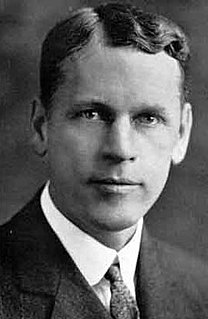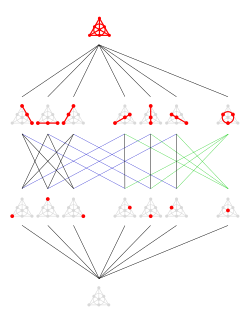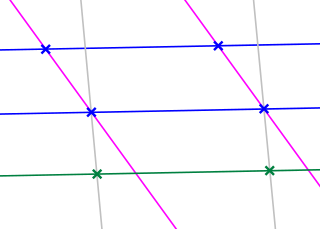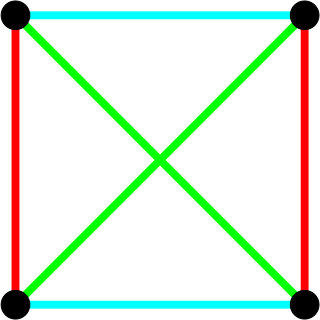In mathematics, the Veblen–Young theorem, proved by OswaldVeblen and John Wesley Young ( 1908 , 1910 , 1917 ), states that a projective space of dimension at least 3 can be constructed as the projective space associated to a vector space over a division ring.

Oswald Veblen was an American mathematician, geometer and topologist, whose work found application in atomic physics and the theory of relativity. He proved the Jordan curve theorem in 1905; while this was long considered the first rigorous proof, many now also consider Camille Jordan's original proof rigorous.
John Wesley Young was an American mathematician who, with Oswald Veblen, introduced the axioms of projective geometry, coauthored a 2-volume work on them, and proved the Veblen–Young theorem.

In mathematics, a projective space can be thought of as the set of lines through the origin of a vector space V. The cases when V = R2 and V = R3 are the real projective line and the real projective plane, respectively, where R denotes the field of real numbers, R2 denotes ordered pairs of real numbers, and R3 denotes ordered triplets of real numbers.
Non-Desarguesian planes give examples of 2-dimensional projective spaces that do not arise from vector spaces over division rings, showing that the restriction to dimension at least 3 is necessary.
In mathematics, a non-Desarguesian plane, named after Girard Desargues, is a projective plane that does not satisfy Desargues' theorem, or in other words a plane that is not a Desarguesian plane. The theorem of Desargues is valid in all projective spaces of dimension not 2, that is, all the classical projective geometries over a field, but David Hilbert found that some projective planes do not satisfy it. Understanding of these examples is not complete, in the current state of knowledge.
Jacques Tits generalized the Veblen–Young theorem to Tits buildings, showing that those of rank at least 3 arise from algebraic groups.

Jacques Tits is a Belgium-born French mathematician who works on group theory and incidence geometry. He introduced Tits buildings, the Tits alternative, the Tits group, and the Tits metric.

In algebraic geometry, an algebraic group is a group that is an algebraic variety, such that the multiplication and inversion operations are given by regular maps on the variety.
Johnvon Neumann ( 1998 ) generalized the Veblen–Young theorem to continuous geometry, showing that a complemented modular lattice of order at least 4 is isomorphic to the principal right ideals of a von Neumann regular ring.

John von Neumann was a Hungarian-American mathematician, physicist, computer scientist, and polymath. Von Neumann was generally regarded as the foremost mathematician of his time and said to be "the last representative of the great mathematicians"; a genius who was comfortable integrating both pure and applied sciences.
In mathematics, continuous geometry is an analogue of complex projective geometry introduced by von Neumann, where instead of the dimension of a subspace being in a discrete set 0, 1, ..., n, it can be an element of the unit interval [0,1]. Von Neumann was motivated by his discovery of von Neumann algebras with a dimension function taking a continuous range of dimensions, and the first example of a continuous geometry other than projective space was the projections of the hyperfinite type II factor.

In the mathematical discipline of order theory, a complemented lattice is a bounded lattice, in which every element a has a complement, i.e. an element b satisfying a ∨ b = 1 and a ∧ b = 0. Complements need not be unique.





